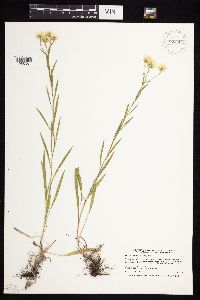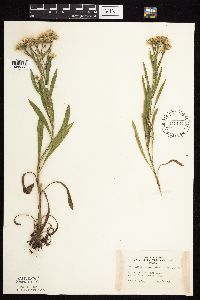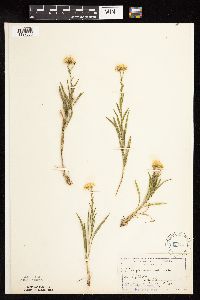Solidago ptarmicoides
|
|
|
|
Family: Asteraceae
Prairie Flat-Top-Goldenrod, more...upland white aster, white flat-top goldenrod
[Aster lutescens (Lindl. ex DC.) Torr. & A. Gray] |
Plants 10-40 cm; caudices branching; vascular bundles and petiole bases marcescent (attached to old stems for more than a season). Stems 1-20+, erect, slender, glabrous proximally, hispid distally. Leaves: basal and proximal cauline persistent, subpetiolate to sessile, blades sometimes 3-nerved, linear to linear-lanceolate, 60-100 × 7-10 mm, stiff, flat, margins entire or subentire, faces glabrous or sparsely hairy ; mid to distal cauline sessile, blades linear oblanceolate to linear, 20-40 × 3-5 mm, reduced distally, margins entire. Heads 1-25(-50) , in corymbiform arrays. Peduncles 29-36.5 mm, strigillose; bracteoles linear. Involucres 5-6 mm. Phyllaries in 4-5 series, usually prominently 1-nerved, linear, strongly unequal, outer acute, inner acute to obtuse, glabrous. Ray florets 10-20, usually white, rarely pale yellow (conspicuous); laminae 7-7.3 × 1.4-1.6 mm. Disc florets 30-36; corollas 3.8-4.1 mm, lobes 0.5-0.7 mm. Cypselae (obconic) 1-1.5 mm (ribbed), glabrous; pappi 3.4-4 mm (apically clavate). 2n = 18. Flowering Jul-Oct. Dry, sandy, usually calcareous soils, cracks in rocks, limestone pavements, rocky outcrops, grassy slopes, prairies; 0-1500 m; Man., Ont., Que., Sask.; Colo., Conn., Ill., Ind., Iowa, Mich., Minn., Mo., Mont., N.H., N.Y., Ohio, Okla., S.C., S.Dak., Vt., Wis., Wyo. L. Brouillet and J. C. Semple (1981) summarized the morphologic, chemical, cytological, and hybridization data on Solidago ptarmicoides and concluded that, except for the white rays, it is a typical member of sect. Ptarmicoidei. The species hybridizes with S. rigida, S. ohioensis, S. riddellii, and perhaps other goldenrods. It is not known to hybridize with any species of aster (regardless of genus); the supposed Aster × Solidago hybrids are the basis of all reports of intergeneric hybrids in the literature. Horticultural hybrids involving S. ptarmicoides and other Solidago species have been treated as S. ×luteus (M. L. Green ex Dress) Brouillet & Semple (×Solidaster luteus M. L. Green ex Dress). Solidago ×bernardii B. Boivin [Oligoneuron ×bernardii (B. Boivin) G. L. Nesom] is the formal name applied to S. ptarmicoides × S. riddellii hybrids; those have cream rays. Solidago ×lutescens (Lindley ex de Candolle) B. Boivin [Diplopappus lutescens Lindley ex de Candolle; D. albus var. lutescens (Lindley ex de Candolle) Hooker ex Torrey & A. Gray; Aster lutescens (Lindley ex de Candolle) Hooker ex Torrey & A. Gray; A. ptarmicoides var. lutescens (Lindley ex de Candolle) A. Gray; Oligoneuron ×lutescens (Lindley ex de Candolle) G. L. Nesom] applies to hybrids between S. ptarmicoides and S. rigida or S. riddellii from the prairies; these also have cream colored rays.
Stems 1-7 dm from a branched caudex, scabrous at least above; lvs firm, glabrous or scabrous, entire or with a few remote salient teeth, tending to be trinerved, 3-20 cm נ1.5-10 mm, the lower linear-oblanceolate and petiolate, sometimes tufted, persistent, and larger than those above, sometimes smaller and deciduous, the others becoming sessile upward and linear or nearly so; heads mostly 3-60 in an open, minutely bracteate, corymbiform infl; invol (4)5-7 mm, glabrous, its bracts imbricate, firm, greenish above but scarcely herbaceous, often with strongly thickened midrib; rays 10-25, white, 5-9 mm; disk-fls numerous, white; achenes glabrous; pappus copious, many of the bristles clavellate- thickened and subplumose toward the tip; 2n=18. Prairies and other open, usually dry, commonly calcareous places; Vt., N.Y., and w. Que. to Ga., w. to Sask., Colo., and Ark. (Aster p.; Unamia p.) Hybrids with S. rigida var. humilis have been called Aster or Unamia or S. جutescens (DC.) B. Boivin; those with S. ohioensis have been called S. ثrotkovii B. Boivin; and those with S. riddellii have been called S. آernardii B. Boivin; European garden-hybrids, presumably with S. canadensis, have been called Solidaster luteus M. L. Green. Gleason, Henry A. & Cronquist, Arthur J. 1991. Manual of vascular plants of northeastern United States and adjacent Canada. lxxv + 910 pp. ©The New York Botanical Garden. All rights reserved. Used by permission. From Flora of Indiana (1940) by Charles C. Deam This species grows in almost pure sand on the low dunes in Lake and Porter Counties. It was formerly frequent in the shifting sands near Indiana Harbor, becoming rare in Porter County. It was reported in Coulter's Catalogue on the authority of Conner & Laben, as occurring in Happy Hollow near Lafayette, in Tippecanoe County. I doubt this determination and, in the absence of a specimen, it is best to restrict its distribution in Indiana to the dune area. …… Indiana Coefficient of Conservatism: C = 10 Wetland Indicator Status: N/A |
































































































